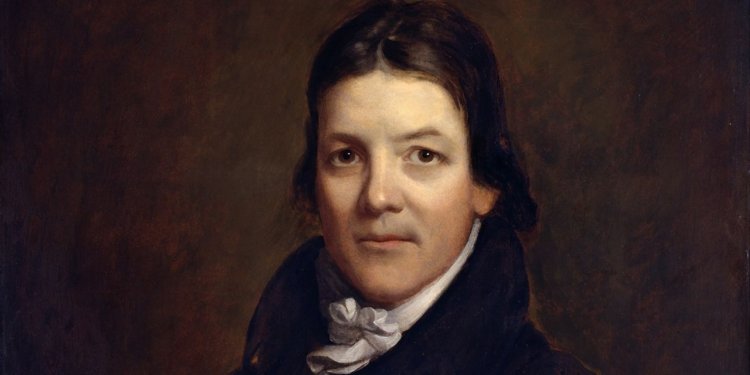‘A Madman’s Will’ Review: Deathbed Directive
John Randolph of Roanoke (1773-1833). Photo: Bridgeman Images By David S. Reynolds April 18, 2023 6:25 pm ET The planter and politician John Randolph of Roanoke, one of the leading defenders of slavery in early-19th-century America, emancipated his nearly 400 enslaved people in his will. Or did he? That mystery drives “A Madman’s Will,” Gregory May’s enlightening, suspenseful book on Randolph’s oft-revised will, which became the subject of prolonged court battles after his death. John Randolph served Virginia in Congress for almost 30 years, mainly in the House of Representatives, with a two-year stint in the Senate. Reed-thin, tall and russet-haired, Randolph had a beardless face and a high, shrill voice—symptoms of a genetic disorder or perhaps an adolescent illness that disrupted puberty. The eccentric Randolph would stride into Congress trai


John Randolph of Roanoke (1773-1833).
Photo: Bridgeman Images
By
David S. Reynolds
The planter and politician John Randolph of Roanoke, one of the leading defenders of slavery in early-19th-century America, emancipated his nearly 400 enslaved people in his will. Or did he? That mystery drives “A Madman’s Will,” Gregory May’s enlightening, suspenseful book on Randolph’s oft-revised will, which became the subject of prolonged court battles after his death.
John Randolph served Virginia in Congress for almost 30 years, mainly in the House of Representatives, with a two-year stint in the Senate. Reed-thin, tall and russet-haired, Randolph had a beardless face and a high, shrill voice—symptoms of a genetic disorder or perhaps an adolescent illness that disrupted puberty. The eccentric Randolph would stride into Congress trailed by hunting dogs that curled up under his desk while he gave brilliant,sarcastic, interminable speeches accentuated by wild gestures.
Early in his career, Randolph, the unmarried heir to a huge Virginia tobacco plantation, took the moderate position that slavery was a necessary evil. He called for restrictions on slavery in the western territories and denounced the slave trade in Washington, D.C. But as time passed, he became an outspoken advocate of the view that the central government must never interfere with the South’s peculiar institution. A champion of states’ rights, he was the only Southerner, Mr. May informs us, who voted against the Missouri Compromise, the face-saving measure that gave concessions to the North while allowing slavery in Missouri.
If Randolph supported slavery, why did he arrange for the freedom of his bondspeople? Due to a paucity of evidence, Mr. May cannot fully answer this question. Randolph clearly differed from his brother Richard, who defended freeing his own 155 enslaved people by denouncing slavery at length as “the most lawless and monstrous tyranny.” John Randolph made no such extended pronouncements. “He did not believe in universal emancipation,” Mr. May writes. “He freed his own slaves in order to suit himself.”
Some facts Mr. May presents do indicate Randolph’s underlying opposition to slavery, despite his intensifying public support of it. In a will that Randolph wrote in 1800,he announced: “It is my desire that every individual negroe of whom I may die possessed be restored to that freedom which is his just & natural right & of which he has been so long & basely deprived.” That early will was undiscovered until long after his death, however. In a will he wrote in 1832, a year before his death, Randolph made no mention of his slaves and left virtually his entire estate to a 2-year-old boy he had never seen, the first child of his niece Elizabeth Bryan. The picture became even murkier when, on his deathbed, Randolph asked witnesses to “confirm every disposition in my will, especially that respecting my slaves, whom I have manumitted.”

Technically, Randolph’s last written will—which did not refer to emancipation—superseded his other wills. But the mixed messages Randolph had sent over the years gave rise to an 11-year court battle over his estate. Lawyers represented opposing groups of Randolph’s relatives and friends, whose motives ranged from sheer greed to altruistic concern for the black people Randolph had owned. Mr. May, a lawyer turned historian, dexterously describes the court hearings, appeals and suits over Randolph’s will.
The fight over Randolph’s estate, Mr. May explains, centered on the question: Was John Randolph mentally ill, and, if so, for how long? His half-brother, the lawyer and novelist Nathaniel Beverley Tucker, maintained that Randolph’s insanity had lasted for decades and that all of his wills were invalid; his estate, therefore, must be divided among his heirs, including Tucker himself. On the other side was Randolph’s friend Judge William Leigh, who claimed that mental illness did not strike Randolph until late in his life, meaning that his last will must be set aside in favor of the 1821 one, in which Randolph had liberated his black people. Leigh selflessly renounced his interest in the 1821 will, in which Randolph had named him as his principal beneficiary.
In 1845, a Petersburg, Va., court ruled that the 383 surviving blacks formerly enslaved by John Randolph must be emancipated. But liberty did not bring security to the freedpeople. Mr. May does an excellent job of describing what he calls the “mirage of freedom” that was the unfortunate destiny of many emancipated blacks at the time. Virginia law required that manumitted blacks must leave the state within a year of being freed. Under the direction of William Leigh, these freedpeople trekked west across the Alleghenies to Ohio, where there were black settlements. But Ohio, though a free state, resented being a sought-after home for the South’s emancipated black people. A white mob in Mercer County and violent incidents elsewhere in Ohio prevented them from settling as a unified community. The group was forced to scatter. Some fled to different states, while others settled in two counties in southwest Ohio.
Mr. May makes an illuminating comparison between Randolph and another Virginia enslaver, Samuel Gist, who liberated more than 300 people. It would have been interesting to hear similar comparisons made to other major figures (mentioned briefly in an endnote), including George Washington, who ordered that his 123 enslaved people be set free upon his wife’s death; Robert Pleasants, who liberated more than 400 bondspeople; and Robert Carter III, who emancipated between 400 and 500.
Such discussions would be icing on a very rich cake. “A Madman’s Will” offers a compelling case history of the complexities of enslavement and emancipation in the young American nation.
Mr. Reynolds is a Distinguished Professor at the Graduate Center of the City University of New York. His books include, most recently, “Abe: Abraham Lincoln in His Times.”
What's Your Reaction?













